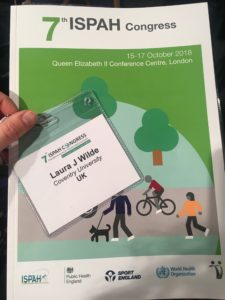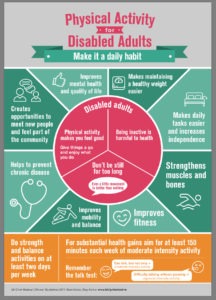
Last week held the 7th International Society for Physical Activity and Health (ISPAH 2018) Congress at the Queen Elizabeth 2nd Conference Centre in London. At my first international conference, I was amazed at the huge number of delegates, quality of research presented, and passion for physical activity and health. The congress began highlighting the developments in physical activity research and implementation over the past few years and unfortunately a lack of change in physical activity levels. From the Congress, I felt there were some clear directions for physical activity and health.
Understanding the people
Throughout the congress there was an importance on understanding people to increase physical activity. Some presentations, keynotes and debates touched upon increasing this understanding, but I felt there was no real emphasis on integrating more qualitative work or co-creation techniques into the designing of physical activity and sedentary behaviour interventions.
Nevertheless, on the first day Gina Radford (Deputy Chief Medical Officer for England) unveiled the Physical 
Integration of technology
During ISPAH 2018, I felt there was a surprising lack of focus on the utilisation of commercially available technology in our everyday lives to increase physical activity. Prof. Nanette Mutrie (University of Edinburgh), during the physical activity guidelines debate session on day three, aided to the fact that technology and understanding the use of technology is the future.
Considering the innovation and development of objective physical activity measurement tools over the recent years, I felt there was still a great deal of research presented which used self-report measures. We know the self-report measures are unreliable as activity levels tend to be overestimated and they also rely on people’s memory of their activities and their interpretation of the questions. I am not sure people really know what moderate-to-vigorous physical activity means let alone what activities in their lives count as moderate-to-vigorous physical activity.
The number of people who track their physical activity or monitor how many steps they take each day is more
Who knows what the future holds for physical activity and health. Maybe we will all have super accurate technology which will know exactly how much time we have spent sitting, walking or exercising. Researchers may use a combination of activity trackers and tiny wearable cameras to getting absolute data on physical activity and sedentary behaviour. Technology may even be able to tell us what doing 10,000 steps has done for our health.
Implementation, dissemination and impact
Over the years not much has changed in terms of improving physical inactivity. Although it could be worse, it’s time there were changes. Researchers, practitioners and policy makers on physical activity need to increase the impact of their work.
During ISPAH 2018 there were a number of wonderful interventions being conducted all over the world in an attempt to increase physical activity. But there are so many! So much time and effort has gone and is going into creating new complex online interventions or mobile phone apps to increase physical activity or reduce sedentary behaviour. If the intervention is successful and it works, why hasn’t it been disseminated across the region, country or world? In an ideal situation, wouldn’t we gather the best parts of all those interventions and create one successful intervention that is appropriately tailored and disseminated across the world?
As Prof. Ross Brownson (Washington University) rightly highlighted researchers, health practitioners and policy makers perceive impact differently. Everyone needs to learn to speak the same language and communicate their learnings to a wider audience with researchers communicating to healthcare practitioners and policy makers and vice versa.
In a global effort to influence, who better to advocate physical activity than Fiona Bull from the World Health Organisation (WHO). The Physical Activity ACTIVE Policy Toolkit was actively launched on day three of ISPAH 2018 with the throwing of WHO footballs (although the instruction was to pass!). The toolkit aims to help governments across the world to reduce the shocking levels of physical inactivity and the related health, social and economic consequences.
More research is needed…
Finally, and obviously, more research is needed… We always need to learn more, we always need to know more.

The world we live in is constantly changing and we can’t really keep up. We need to know more about how people use the available technology and integrate it into their lives. We need to try to keep up with advancements in technology and understand how it is being used and how researchers, health care practitioners and policy makers can utilise its use to increase physical activity globally.
Hopefully my own PhD research will help us to understand more about how people use technology for monitoring their physical activity and sedentary behaviour.
However, we can’t necessarily wait for the research to be conducted and published before we take action.
Looking forward to ISPAH 2020 for the 8th Congress in Vancouver. I wonder what ground breaking developments will be made over the next 2 years for physical activity and health!
Thank you for reading!
Do get in touch if you have any questions, comments or thoughts and do take a look at my poster presentation for ISPAH 2018 on the preliminary findings from a systematic review of the barriers and facilitators to using mobile phone apps and wearables for monitoring physical activity and sedentary behaviour.

Business Cooperation – Purchase Your Site Traffic
How to earn more income with your website ?
Media Advertising Platform runs the #2 largest contextual ads program globally and can generate a great deal of revenue for your website.
You will get high converting ad design options, the ad units look like navigation menus, so it will result in a very high Click Through Rate.
You’re also allowed to place ads in sticky or fixed sidebar zones.This is a HUGE benefit. You can not place Adsense ads in a floating/fixed/sticky sidebar zone.
Visit here to sign up (bonus 10% revenue for first 3 months) : https://www.biglep.com/earn
{Thank you|Thanks|Thanks a lot,
Valery Wakenight
IMPORTANT: Remember to ask your customer service representative to help you {optimize|improve} ads,their ad design will dramatically increased {revenue|income|earnings}!!
*Unsubscribe*: Reply “NO”